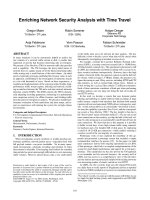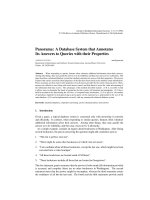Internetworking with TCP/IP- P51 pot
Bạn đang xem bản rút gọn của tài liệu. Xem và tải ngay bản đầy đủ của tài liệu tại đây (490.22 KB, 10 trang )
For
Further
Study
FOR FURTHER STUDY
BOOTP is a standard protocc
)1
in
the TCP/LF' suite. Further details can
be
found
in
Croft and Gilmore
[RFC
9511,
which compares BOOTP to
RARP
and serves as the of-
ficial standard. Reynolds [RFC
10841
tells how to interpret the vendor-specific area,
and Braden [RFC
11231
recommends using the vendor-specific area to pass the subnet
mask.
Droms
[RFC
21311
contains the specification for DHCP, including a detailed
description of state transitions; another revision is expected soon.
A
related document,
Alexander and Droms
[RFC
21321,
specifies the encoding of DHCP options and
BOOTP vendor extensions. Finally, Droms
[RFC
15341
discusses the interoperability
of BOOTP and DHCP.
EXERCISES
BOOTP does not contain an explicit field for returning the time of day from the server
to the client, but makes it part of the (optional) vendor-specific information. Should the
time
be
included in the required fields? Why or why not?
Argue that separation of configuration and storage of memory images is
not
good. (See
RFC
951
for hints.)
The BOOTP message format is inconsistent because it has two fields for client
IP
ad-
dress and one for the name of the boot image.
If
the client leaves its
IP
address field
empty, the server returns the client's
IP
address in the second field.
If
the client leaves
the boot file name field empty, the server
replaces
it with an explicit name. Why?
Read the standard to find out how clients and servers use the
HOPS
field.
When a BOOTP client receives a reply via hardware broadcast, how does it know
whether the reply is intended for another BOOTP client on the same physical net?
When a machine obtains its
subnet mask with BOOTP instead of ICMP, it places less
load on
other
host computers. Explain.
Read the standard to find out how a DHCP client and server can agree on a lease dura-
tion without having synchronized clocks.
Consider a host that has a disk and uses DHCP to obtain an
IP
address. If the host
stores its address on disk along with the date the lease expires, and then reboots within
the lease
period,
can it use the address? Why or why not?
DHCP mandates a minimum address lease of one hour. Can you imagine a situation in
which DHCP's minimum lease causes inconvenience? Explain.
Read the
RFC to find out how DHCP specifies renewal and rebinding timers. Should a
server ever set one without the other? Why or why not?
The state transition diagram does not show retransmission. Read the standard to find out
how many times a client should retransmit a request.
460
Bootstrap
And
Autoconfiguration
(BOOTP,
DHCP) Chap.
23
23.12
Can DHCP guarantee that a client is not "spoofing" (i.e., can DHCP guarantee that it
will not send configuration information for host
A
to host
B)?
Does the answer differ for
BOOTP?
Why
or why not?
23.13
DHCP specifies that a client must be prepared to handle at least
312
octets of options.
How did the number
312
arise?
23.14
Can a computer that uses DHCP to obtain an
IP
address operate a server?
If
so, how
does a client reach the server?
The Domain Name System
24.1
Introduction
The protocols described in earlier chapters use 32-bit integers called Internet Proto-
col addresses
(IP
addresses) to identify machines. Although such addresses provide a
convenient, compact representation for specifying the source and destination
in
packets
sent across an internet, users prefer to assign machines pronounceable, easily remem-
bered names.
This chapter considers
a
scheme for assigning meaningful high-level names to a
large set of machines, and discusses a mechanism that maps between high-level
machine names and
IP
addresses. It considers both the translation from high-level
names to
IP
addresses and the translation from
IP
addresses to high-level machine
names. The naming scheme is interesting for two reasons. First, it has been used to as-
@
sign machine names throughout the global Internet. Second, because it uses a geo-
graphically distributed set of servers to map names to addresses, the implementation of
c-
the name mapping mechanism provides a large scale example of the client-server para-
digm described
in
Chapter 21.
The Domain
Name
System
(DNS)
Chap. 24
24.2 Names For Machines
The earliest computer systems forced users to understand numeric addresses for ob-
jects like system tables and peripheral devices. Timesharing systems advanced comput-
ing by allowing users to invent meaningful symbolic names for both physical objects
(e.g., peripheral devices) and abstract objects (e.g., files).
A
similar pattern has emerged
in computer networking. Early systems supported point-to-point connections between
computers and used low-level hardware addresses to specify machines. Internetworking
introduced universal addressing as well as protocol software to map universal addresses
into low-level hardware addresses. Because most computing environments contain mul-
tiple machines, users need meaningful, symbolic names to identify them.
Early machine names reflected the small environment
in
which they were chosen.
It was quite common for a site with a handful of machines to choose names based on
the machines' purposes. For example, machines often had names like
research, produc-
tion, accounting,
and
development.
Users find such names preferable to cumbersome
hardware addresses.
Although the distinction between
address
and
name
is intuitively appealing, it is
artificial. Any
name
is merely an identifier that consists of a sequence of characters
chosen from a finite alphabet. Names are only useful
if
the system can efficiently map
them to the object they denote. Thus, we think of an
IP
address as a
low-level name,
and we say that users prefer
high-level names
for machines.
The form of high-level names is important because it determines how names are
translated to low-level names or bound to objects, as well as how name assignments are
authorized. When only a few machines interconnect, choosing names is easy, and any
form will suffice. On the Internet, to which approximately one hundred million
machines connect, choosing symbolic names becomes difficult. For example, when its
main departmental computer was connected to the Internet
in
1980, the Computer Sci-
ence Department at Purdue University chose the name
purdue
to identify the connected
machine. The list of potential conflicts contained only a few dozen names.
By mid
1986, the official list of hosts on the Internet contained 3100 officially registered names
and 6500 official
aliasest. Although the list was growing rapidly in the 1980s, most
sites had additional machines
(e.g., personal computers) that were not registered.
24.3 Flat Namespace
The original set of machine names used throughout the Internet formed a
flat
namespace
in which each name consisted of a sequence of characters without any
furth-
er structure. In the original scheme, a central site, the Network Information Center
(NZC),
administered the namespace and determined whether a new name was appropri-
ate (i.e., it prohibited obscene names or new names that conflicted with existing names).
The chief advantage of a flat namespace is that names are convenient and short; the
chief disadvantage is that a flat namespace cannot generalize to large sets of machines
for both technical and administrative reasons. First. because names are drawn from a
tBy
1990,
more than 137,000 Internet hosts had names, and by 2000
the
number
exceeded
60
million.
Sec.
24.3
Flat
Namespace
463
single set of identifiers, the potential for conflict increases as the number of sites in-
creases. Second, because authority for adding new names must rest at a single site, the
administrative workload at that central site also increases with the number of sites. To
understand the severity of the problem, imagine a rapidly growing internet with
thousands of sites, each of which has hundreds of individual personal computers and
workstations. Every time someone acquires and connects a new personal computer, its
name must be approved by the central authority. Third, because the name-to-address
bindings change frequently, the cost of maintaining correct copies of the entire list at
each site is high and increases as the number of sites increases. Alternatively, if the
name database resides at a single site, network traffic to that site increases with the
number of sites.
24.4
Hierarchical Names
How can a naming system accommodate a large, rapidly expanding set of names
without requiring a central site to administer it? The answer lies in dzntralizing $e
naming mechanism by delegating authority for parts of the namespace and distributing
rGponsibility f;lr the mapping between names and addresses. TCPIIP internets use such
a scheme. Before examining the details of the TCPIIP scheme, we will consider the
motivation and intuition behind it.
The partitioning of a namespace must be defined in a way that supports efficient
name mapping and guarantees autonomous control of name assignment. Optimizing
only for efficient mapping can lead to solutions that retain a flat namespace
and
reduce
traffic by dividing the names among multiple mapping machines. Optimizing only for
administrative ease can lead to solutions that make delegation of authority easy but
name mapping expensive or complex.
To understand how the namespace should be divided, consider the internal struc-
ture of large organizations. At the top, a chief executive has overall responsibility. Be-
cause the chief executive cannot oversee everything, the organization may be partitioned
into divisions, with an executive in charge of each division. The chief executive grants
each division autonomy within specified limits. More to the point, the executive in
charge of a particular division can hire or fire employees, assign offices, and delegate
authority, without obtaining direct permission from the chief executive.
Besides making it easy to delegate authority, the hierarchy of a large organization
introduces autonomous operation. For example, when an office worker needs informa-
tion like the telephone number of a new employee, he or she begins by asking local
clerical workers (who may contact clerical workers in other divisions). The point is that
although authority always passes down the corporate hierarchy, information can flow
across the hierarchy from one office to another.
-
-
464
The
Domain Name System
(DNS)
Chap.
24
24.5
Delegation
Of
Authority For Names
A hierarchical naming scheme works like the management of a large organization.
The namespace is
partitioned
at the top level, and authority for names in subdivisions is
passed to designated agents. For example, one might choose to partition the namespace
based on
site name
and to delegate to each site responsibility for maintaining names
within its partition.
The topmost level of the hierarchy divides the namespace and
delegates authority for each division; it need not be bothered by changes within a divi-
sion.
The syntax of hierarchically assigned names often reflects the hierarchical delega-
tion of authority used to assign them. As an example, consider a namespace with
names of the form:
local. site
where
site
is the site name authorized by the central authority,
local
is the part of a
name controlled by the site, and the period?
(".")
is a delimiter used to separate them.
When the topmost authority approves adding a new site,
X,
it adds
X
to the list of valid
sites and delegates to site
X
authority for all names that end in
"
.X
".
24.6
Subset Authority
In a hierarchical namespace, authority may be further subdivided at each level. In
our example of partition by sites, the site itself may consist of several administrative
groups, and the site authority may choose to subdivide its namespace among the groups.
The idea is to keep subdividing the namespace until each subdivision is small enough to
be manageable.
Syntactically, subdividing the namespace introduces another partition of the name.
For example, adding a
group
subdivision to names already partitioned by site produces
the following name syntax:
local. group. site
Because the topmost level delegates authority, group names do not have to agree among
all sites.
A university site might choose group names like
engineering, science,
and
arts,
while a corporate site might choose group names like
production, accounting,
and
personnel.
The U.S. telephone system provides another example of a hierarchical naming syn-
tax. The 10 digits of a phone number have been partitioned into a 3-digit
area code,
3-
digit
exchange,
and Cdigit
subscriber number
within the exchange. Each exchange has
authority for assigning subscriber numbers within its piece of the namespace. Although
it is possible to group arbitrary subscribers into exchanges and to group arbitrary ex-
changes into area codes, the assignment of telephone numbers is not capricious; they are
carefully chosen to make it easy to route phone calls across the telephone network.
tIn
domain names, the
period
delimiter is pronounced "dot."
Sec.
24.6
Subset
Authority
465
The telephone example is important because it illustrates a key distinction between
the hierarchical naming scheme used in a
TCP/rP
internet and other hierarchies: parti-
tioning the set of machines owned by an organization along lines of authority does not
necessarily imply partitioning by physical location. For example, it could be that at
some university, a single building houses the mathematics department as well as the
computer science department. It might even turn out that although the machines from
these two groups fall under completely separate administrative domains, they connect to
the same physical network. It also may happen that a single group owns machines on
several physical networks. For these reasons, the
TCP/IP
naming scheme allows arbi-
trary
delegation of authority for the hierarchical namespace without regard to physical
connections. The concept can be summarized:
In a
TCP/IP
internet, hierarchical machine names are assigned ac-
cording to the structure of organizations that obtain authority for
parts of the
namespace, not necessarily according to the structure of
4
the physical network interconnections.
Of course, at many sites the organizational hierarchy corresponds with the structure of
physical network interconnections. At a large university, for example, most depart-
ments have their own local area network. If the department is assigned part of the nam-
ing hierarchy, all machines that have names in its part of the hierarchy will also connect
to a single physical network.
24.7
Internet Domain Names
The mechanism that implements a machine name hierarchy for
TCPm
internets is
called the
Domain Name System (DNS).
DNS has two, conceptually independent as-
pects. The first is abstract: it specifies the name syntax and rules for delegating authori-
ty
over names. The second is concrete: it specifies the implementation of a distributed
computing system that efficiently maps names to addresses. This section considers the
name syntax, and later sections examine the implementation.
The domain name system uses a hierarchical naming scheme known as
domain
names.
As in our earlier examples, a domain name consists of a sequence of subnames
separated by a delimiter character, the period. In our examples we said that individual
sections of the name might represent sites or groups, but the domain system simply
calls each section a
label.
Thus, the domain name
cs .purdue
.
edu
contains three labels:
cs, purdue,
and
edu.
Any suffix of a label in
a
domain name is
also called a
domain.
In
the above example the lowest level domain is
cs .purdue. edzi,
(the domain name for the Computer Science Department at Purdue University), the
second level domain is
purdue. edu
(the domain name for Purdue University), and the
466
The Domain Name System (DNS) Chap.
24
top-level domain is
edu
(the domain name for educational institutions). As the example
shows, domain names are written with the local label first and the top domain last. As
we will see, writing them in this order makes it possible to compress messages that con-
tain multiple domain names.
24.8
Official And Unofficial Internet Domain Names
In theory, the domain name standard specifies an abstract hierarchical namespace
with arbitrary values for labels. Because the domain system dictates only the form of
names and not their actual values, it is possible for any group that builds an instance of
the domain system to choose labels for all parts of its hierarchy. For example, a private
company can establish a domain hierarchy in which the top-level labels specify cor-
porate subsidiaries, the next level labels specify corporate divisions, and the lowest level
labels specify departments.
However, most users of the domain technology follow the hierarchical labels used
by the official Internet domain system. There are two reasons. First, as we will see, the
Internet scheme is both comprehensive and flexible. It can accommodate a wide variety
of organizations, and allows each group to choose between geographical or organiza-
tional naming hierarchies. Second, most sites follow the Internet scheme so they can at-
tach their
TCPIIP
installations to the global Internet without changing names. Because
the Internet naming scheme dominates almost all uses of the domain name system, ex-
amples throughout the remainder of this chapter have labels taken from the Internet
naming hierarchy. Readers should remember that, although they are most likely to en-
counter these particular labels, the domain name system technology can be used with
other labels if desired.
The Internet authority has chosen to partition its top level into the domains listed
in Figure
24.
l
t.
Domain Name
COM
EDU
GOV
MIL
NET
ORG
ARPA
INT
country code
Meaning
Commercial organizations
Educational institutions (4-year)
Government institutions
Military groups
Major network support centers
Organizations other than those above
Temporary ARPANET domain (obsolete)
International organizations
Each country (geographic scheme)
Figure
24.1
The top-level Internet domains and their meanings. Although la-
bels are shown in upper case, domain name system comparisons
are insensitive to case, so
EDU
is equivalent to
edu.
fThe
following additional toplevel domains have been proposed, but not formally adopted:
FIRM,
STORE, WEB, ARTS, REC, INFO,
and
NOM.
Sec.
24.8
Official And Unofficial Internet Domain Names
467
Conceptually, the top-level names permit two completely different naming hierar-
chies: geographic and organizational. The geographic scheme divides the universe of
machines by country. Machines in the United States fall under the top-level domain
US;
when a foreign country wants to register machines in the domain name system, the
central authority assigns the country a new top-level domain with the country's interna-
tional standard 2-letter identifier as its label. The authority for the US domain has
chosen to divide it into one second-level domain per state. For example, the domain for
the state of Virginia is
As an alternative to the geographic hierarchy, the top-level domains also allow or-
ganizations to be grouped by organizational type. When an organization wants to parti-
cipate in the domain naming system, it chooses how it wishes to be registered and re-
quests approval. The central authority reviews the application and assigns the organiza-
tion a
subdomain? under one of the existing top-level domains. For example, it is pos-
sible for a university to register itself as a second-level domain under
EDU
(the usual
practice), or to register itself under the state and country in which it is located. So far,
few organizations have chosen the geographic hierarchy; most prefer to register under
COM,
EDU,
MIL,
or
GOV.
There are two reasons.
First, geographic names are longer
and therefore more difficult to type. Second, geographic names are much more difficult
to discover or guess. For example, Purdue University is located
in
West Lafayette, In-
diana. While a user could easily guess an organizational name, like
purdue.edu,
a geo-
graphic name is often difficult to guess because it is usually an abbreviation, like
m
.
us.
laf.
'
Another example may help clarify the relationship between the naming hierarchy
and authority for names. A machine named
xinu
in the Computer Science Department
at Purdue University has the official domain name
xinu. cs .purdue
.
edu
The machine name was approved and registered by the local network manager in the
Computer Science Department. The department manager had previously obtained au-
thority for the subdomain
cs .purdue. edu
from a university network authority, who had
obtained permission to manage the subdomain
purdue. edu
from the Internet authority.
The Internet authority retains control of the
edu
domain, so new universities can only
be
added with its permission. Similarly, the university network manager at Purdue Univer-
sity retains authority for the
purdue. edu
subdomain, so new third-level domains may
only be added with the manager's permission.
Figure 24.2 illustrates a small part of the Internet domain name hierarchy. As the
figure shows, Digital Equipment Corporation, a commercial organization, registered as
dec
.
corn,
Purdue University registered as
purdue
.
edu,
and the National Science Foun-
dation,
a
government agency, registered as
nsf.gov.
In contrast, the Corporation for
National Research Initiatives chose to register under the geographic hierarchy as
cnri
.
reston.
va
.
us$.
?The standard does not define the term "subdomain." We have chosen to
use
it because its analogy to
"subset" helps clarify the relationship among domains.
$Interestingly,
CNRI
also registered using the name
nri.
reston.
va
.
us.
The Domain Name System @NS)
Chap.
24
n
-
unnamed
root
cnri
0
Figure
24.2
A
small part of the Internet domain name hierarchy (tree). In
practice, the
tree.
is
broad and flat; most host entries appear
by
the fifth level.
24.9
Named Items And Syntax
Of
Names
The domain name system is quite general because it allows multiple naming hierar-
chies to
be
embedded in one system. To allow clients to distinguish among multiple
types of entries, each named item stored in the system is assigned a
type
that specifies
whether it is the address of a machine, a mailbox,
a
user, and so on. When a client asks
the domain system to resolve a name, it must specify the type of answer desired. For
example, when an electronic mail application uses the domain system to resolve a
name, it specifies that the answer should be the address of a
mail exchanger.
A
remote
login application specifies that it seeks a machine's IP address. It is important to under-
stand the following:
A
given name may map to more than one item in the domain system.
The client spec@es the type of object desired when resolving a name,
and the server returns objects of that type.
In addition to specifying the type of answer sought, the domain system allows the
client to specify the protocol family to use. The domain system partitions the entire set
of names by
class,
allowing a single database to store mappings for multiple protocol
suites?.
?In
practice, few domain servers use multiple protocol suites.









